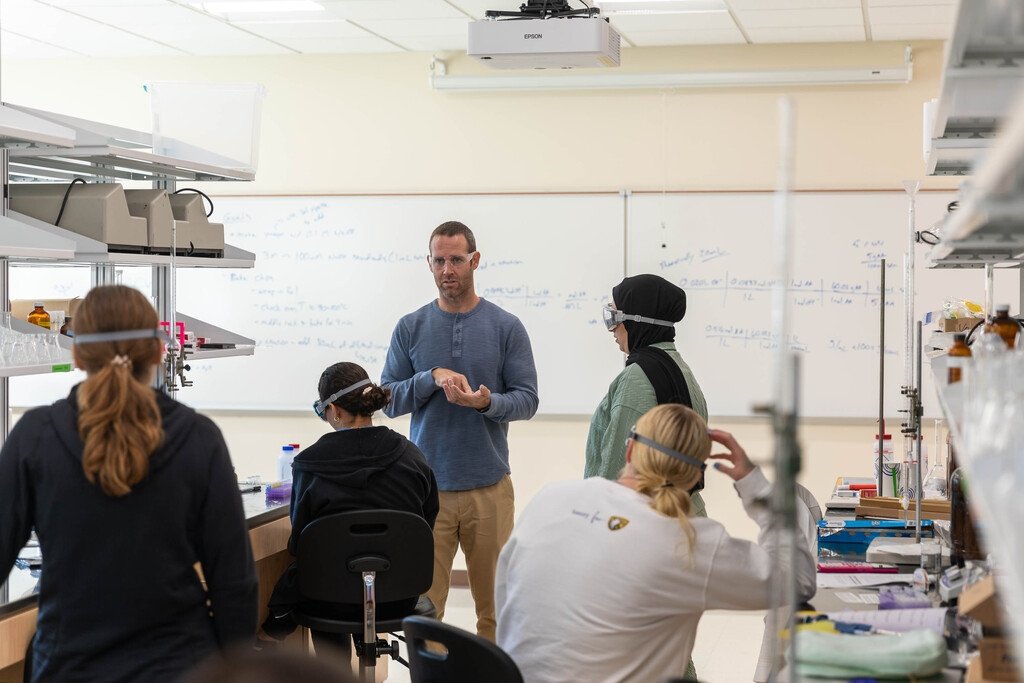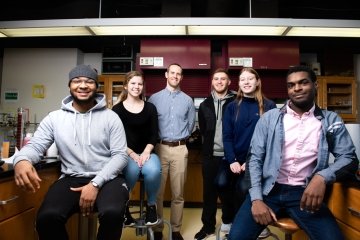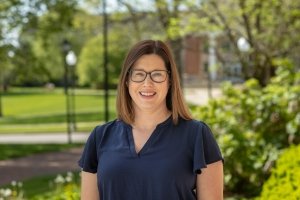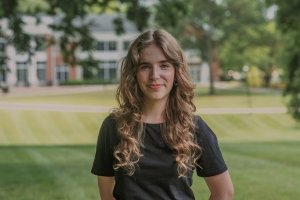Centre professor, students working toward rapid, affordable medical diagnostics

One Centre College professor is researching improved testing equipment for health care. We learn more about his motivation — and how students have helped the research progress.
What are the real-world applications of chemistry?
It’s the question that attracted Centre College Associate Professor Daniel Scott to the subject, and it’s a question that he has helped answer as a professor and as a researcher.
Scott and a team of students have worked on point-of-care diagnostics that could lower barriers to health care for patients from low-income areas and have many more real-world applications through accurate, affordable medical testing.
Point-of-care diagnostics are medical tests done at home, in the field, or at the doctor’s office with near-immediate results. Think rapid COVID tests, but expanded to identify other health concerns.
The research has been what Scott described as a perfect example of the liberal arts and sciences in general — he has folded in majors from chemistry, chemical physics, biochemistry and molecular biology, while working with engineering minors as well.
“This research has brought in a lot of different disciplines together for a common purpose,” he said.
This work ties into the reason Scott loves science: He wants to help people. As a professor, he has seen students learn and grow as scientists. And, as a researcher, he is hoping to break barriers to fast, accurate diagnostic testing.

“So far, we’ve had promising results with a cancer biomarker, a tuberculosis biomarker and a protein biomarker that signals inflammation,” Scott said – meaning the tests can identify those health problems right in the doctor’s office. “Finding those things early really improves outcomes and treatment plans — particularly for rural doctor offices or pop-up clinics, things like that.”
It could also help doctors provide treatment to patients they may not see often. Waiting on lab results could take days, but a test that takes only minutes could allow patients to leave the doctor’s office with a treatment plan in place. And the tests are inexpensive — Scott said the current cost of tests is less than a dollar.
The process has been rewarding, Scott said, for both him and the students: “Some of my inspiration is working with students and seeing them progress as scientists, seeing what it’s like to actually ‘do science,’ the collaborative nature of it and how the different pieces work together — that helps break down barriers,” he said. “Students can put things in silos and say ‘I learned this in my biochemistry and molecular biology class, my chemistry class, my business class.’ But all of these things can work together, and research takes multiple people with different expertise.”
He started this research without much knowledge of the paper-based microfluidics that would be the foundation for these tests, but his work with nanoparticles helped pave the way to more understanding and research opportunity.
Scott had published research previously on loading and selectively releasing anti-cancer drugs with gold nanoparticles, which allows for a controlled release of the drugs when they reach cancerous cells in the body.
“The focus of that project was to hone ‘the delivery of cancer drugs’ in on tumor regions, not to the entire system that some chemotherapies take,” Scott said. “We showed that we could load cancer drugs into a nanoparticle and selectively release them.”
That helped lay the groundwork for Scott’s upcoming publication on the point-of-care diagnostics. It’s a project that began before the COVID-19 pandemic and the rise of rapid testing and diagnosis, which only accelerated the research for Scott.
“We wrapped up the drug delivery research and shifted gears during COVID, we saw a quick path to meeting this need,” Scott said.
Scott said it helps to have current, real-world application with what students are doing in class, which is what the paper-based microfluidics have provided (thanks in part to a grant from the National Science Foundation). Students can “get comfortable with failure” in the lab, making baby steps toward the goal of contributing to research.
“I’d encourage students to ask their professors, get involved with research early. All the students that are on the papers were working with me for multiple years,” Scott said. “That’s where you gain experience and expertise — if you’re interested or excited about a topic, see what research opportunities are available on campus.”
Student research team:
On the paper linked in article:
Daniel Low ’22 (biochemistry and molecular biology major)
Gracie Fitzgerald ’21 (chemical physics)
Cole Hilt ’21 (chemistry)
Luc Morgan (chemistry, class of 2024)
Micai Benford ’20 (chemical physics)
Other students who have or are currently researching with Scott:
Maddie Jenkin '22 (biochemistry and molecular biology)
Marielena Villaran '22 (chemistry)
Lilly Zehnder (biology, class of 2025)
Tenley Soergel (religion, class of 2025)
Erika Alonso (chemistry, class of 2025)
Geovanna de Andrade (chemistry, class of 2025)
Ashton Whitt (physics, class of 2024)



